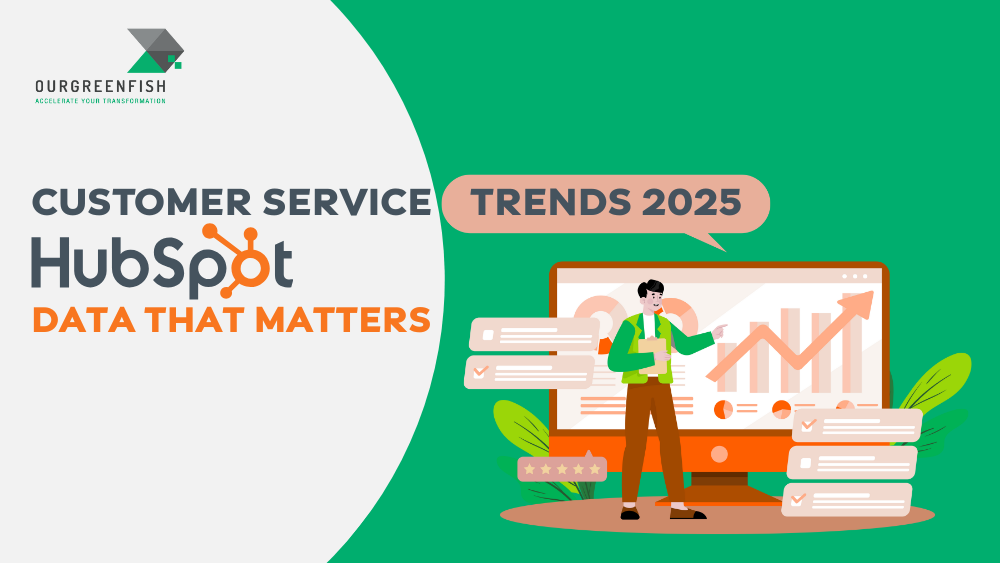Customer Service Trends 2025 : Customer Behavior and Expectations in 2025
Customer behavior has significantly shifted as we step into 2025. Businesses are discovering that customers no longer reach out to service teams solely via phone or email. Instead, they increasingly prefer digital channels such as SMS, online chat, and social media. This has made the customer journey more complex and unique. Evidence also shows that a growing number of customers prefer solving problems themselves before turning to company support.
This trend poses challenges for service leaders in understanding customer needs across interactions. However, HubSpot highlights three core factors that remain consistent across all channels: speed of issue resolution, availability of Self-Service, and personalized responses.
Speed as the top priority: Today’s customers expect rapid resolutions. The report found that more than half of service leaders say their customers expect issues to be solved within three hours or less. Delayed responses increase dissatisfaction and the likelihood of churn. At the same time, customers want businesses to provide personalized communication, remembering their context and history with every interaction. In short, customers in 2025 are both impatient and highly attentive to personalized service. Businesses capable of delivering fast and tailored experiences will enjoy a clear competitive edge.
Customer Service Trends 2025 : The Role of AI and Chatbots in Customer Service
Artificial Intelligence (AI) and Chatbots have become essential tools in transforming customer service. Today, over 75% of service leaders report using AI tools in their daily operations.
AI is no longer just a buzzword—it has proven to enhance customer experiences while boosting operational efficiency without excessive costs. AI’s ability to process customer data and language enables agents to deliver faster and more accurate solutions. For example, AI can take over certain cases via chatbots, shortening resolution times while maintaining customer satisfaction. Businesses report that AI has improved response times and raised CSAT scores when integrated into service operations.
Chatbots, in particular, are gaining prominence. The report shows that tech-savvy customers often turn to chatbots to solve issues before calling a contact center or sending an email. Well-configured chatbots can handle FAQs, guide customers through troubleshooting, and escalate complex cases to human agents. This collaboration between AI/Chatbots and human staff ensures response times remain within expectations and frees agents to tackle more complex issues.
Notably, 71% of service leaders plan to increase AI investments in 2024, predicting that AI will be able to manage the majority of routine customer requests by 2025. This trend suggests that AI and Chatbots are no longer optional add-ons but are fast becoming the new standard of customer service.
Customer Service Trends 2025 : Self-Service and Omnichannel Trends
Self-Service and Omnichannel service are two of the most dominant trends for 2025. As demand for speed grows, customers increasingly prefer solving problems independently. HubSpot reports that 78% of service leaders believe their customers are willing to troubleshoot on their own before contacting support.
These “DIY customers” dislike waiting for replies or repeating their issues to multiple agents. Instead, they look to knowledge bases, FAQs, or online resources for quick solutions. This means that businesses with well-developed information centers can deflect a large volume of tickets, empowering customers and reducing team workloads. In fact, 68% of CRM leaders planned to prioritize self-service initiatives starting in 2024.
Meanwhile, Omnichannel support has become the baseline expectation. Customers demand the ability to connect with businesses through their preferred channels—be it Facebook, LINE, live chat, email, or phone—and they expect a seamless and consistent experience across all platforms. HubSpot found that omnichannel support helps service teams manage tickets faster, which is crucial at a time when 75% of leaders say their teams are handling more support requests than ever before.
To meet these expectations, businesses must ensure that customer interactions across all channels are synchronized and stored in centralized systems like a CRM. Without this, customers may have to repeat their issues multiple times, leading to frustration. Interestingly, many customers even prefer online chat and chatbot interactions over phone or email due to their speed and convenience. Companies capable of responding in customers’ preferred channels will not only boost satisfaction but also strengthen retention.
Key Statistics : CSAT, Resolution Time, and CRM Tools
HubSpot’s State of Customer Service 2024 highlights several key statistics that shed light on the state of customer service in 2025:
- Customer Satisfaction (CSAT) is on the rise : Despite the challenges of adopting new tools and strategies, most service leaders successfully maintained or improved CSAT in 2023. Faster and more attentive service directly correlates with higher retention. Moreover, leaders reported that CSAT scores are higher when AI tools such as chatbots are used alongside human agents.
- Resolution time expectations are tighter : More than 50% of CRM leaders report that customers now expect their issues to be resolved within three hours or less, compared to a minority (~32%) who are willing to wait longer. This pressure has forced organizations to adopt strategies such as hiring more agents, implementing self-service options, and using AI to reduce resolution times. Quick responses are directly linked to lower churn rates.
- CRM adoption remains limited : While CRM tools are critical for integrating customer data and enabling efficient service, the report found that only 68% of organizations use CRM for daily service operations. This means about one-third of businesses risk missing out on the benefits of centralized data. Even more concerning, only 35% of leaders say their customer data is fully integrated with their service tools. The lack of integration forces service agents to switch between multiple systems—HubSpot reveals that the average service agent uses four different tools daily—slowing resolution times and increasing stress levels. Businesses that consolidate their tools and use CRM as a “single source of truth” will be better positioned to deliver fast and seamless service.
Customer Service Trends 2025 : Recommendations for Businesses to Adapt
Based on these insights, businesses should act decisively to align with evolving customer expectations. HubSpot highlights several strategies that leading organizations are already adopting:
- Leverage AI across the customer journey: From chatbots handling FAQs to AI-driven data analysis for personalization, businesses must invest in AI to increase speed and quality of service. (73% of service leaders plan to increase AI investment in 2024.)
- Deliver true Omnichannel support: Ensure customers can reach your business through all major channels with seamless transitions. (65% of organizations increased budgets for omnichannel service in 2024.)
- Adopt CRM as a single source of truth: Consolidate data across sales, marketing, and service to improve accuracy, eliminate silos, and accelerate resolution. (64% of businesses planned to expand CRM use in 2024.)
- Expand Self-Service options: Build and optimize knowledge bases, FAQs, and customer communities to empower customers and reduce ticket volume. (64% of leaders planned more investment in self-service in 2024.)
- Enhance personalization: Use customer history and behavioral data to deliver tailored responses, boosting both CSAT and customer lifetime value. (62% of companies invested in personalization tools in 2024.)
These strategies help businesses adapt to the fast-changing service landscape. Owners should start by identifying the biggest gaps in their current operations, then gradually invest in solutions that align with customer expectations—whether through AI enhancements, staff training, or CRM integration.
Customer Service Trends 2025 is defined by both evolving customer behavior and the technologies businesses use to respond. According to HubSpot’s insights, modern customers demand service that is fast, personalized, and available across multiple channels. At the same time, AI and Chatbots are becoming indispensable, enabling scalability and efficiency. Self-Service and Omnichannel experiences are no longer optional—they are expectations.
Statistics such as improved CSAT with AI, shrinking resolution time windows, and CRM adoption gaps underscore the urgent need for businesses to stay agile. Companies that act on these insights—investing in the right technologies and empowering their teams—will not only delight their customers but also secure long-term growth in an era where customer service is the ultimate driver of business success.
Reference: HubSpot. (2024). 2024 Annual State of Service Trends Report. Retrieved from https://offers.hubspot.com/state-of-customer-service
Read more articles : Customer service is one of the hearts of doing business. (การบริการลูกค้า (Customer Service) หนึ่งในหัวใจสำคัญของการทำธุรกิจ)
Contact us
Tel : +66 2-0268918
E-mail : contact@ourgreen.co.th
Website : ourgreenfish.com

.webp?width=158&height=85&name=New-logo-Ourgreen%20(1).webp)














.png)


No Comments